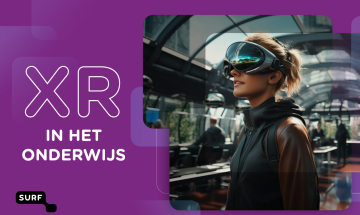"You get into the heart of a nuclear power plant or into a world at the molecular level."
What are the possibilities, opportunities, applications, challenges and obstacles of eXtended Reality for education? Who are engaged in this? Where are we now and where are we going? Read about it in the issue XR in education.
What is XR and what can it do?
Immersive reality or XR (eXtended Reality) is a term that encompasses all immersive technologies that expand our perception of reality, such as Virtual Reality (VR), Augmented Reality (AR) and Mixed Reality (MR). VR creates a completely computer-generated environment that replaces the real world.
XR can be a very good way to create special learning experiences for students. For example, through VR simulations, students gain access to environments that are difficult or inaccessible in real life. VR simulations offer students very practical training and practice opportunities in real-life conditions without pressure, risk or danger. Exercises that can also be repeated endlessly independent of location and time.
Deep in the ocean
According to Arno Freeke, coordinator of the VR Lab at TU Delft, XR in education is mainly about enriching the learning environment and creating an experience for students that you cannot realise in real life. "For example, you get into the heart of a nuclear power plant, deep in the ocean, high in the atmosphere or in a world at the molecular level." Gert-Jan Verheij, team lead visualisation at the RUG, has a credo that you should only deploy XR if you can do something with it that you can't do otherwise. Because only then is it viable. "Don't do it just because you think XR is fun and new. That fun often only works a few times and then the fun and novelty wears off. Yet I still regularly hear people say they think VR is cool and want a headset too. Be careful before you start, I would say."
"Students are often open to exciting things in a virtual world."
Few hundred euros
According to visualisation experts Paul Melis and Casper van Leeuwen of SURF, technology has currently reached the point where many cool things are possible. "For a few hundred euros you have a device with which you can play games ánd use an application in your education with interaction and good image quality. For content creation, a lot of use is made of gaming engines: software for developing games. With these, you can create your own content relatively easily, such as a virtual 3D environment."
Toxic substances
John Walker (SURF) also thinks it is important to take into account that students are often open to exciting things in a virtual world. "Throwing stuff, jumping off a cliff and mixing toxic substances in a lab. They will do it all. Because it's both fun and safe. And for students, VR also remains a great place to be able and allowed to fail. You shouldn't underestimate that because it helps them arrive at answers and solutions faster and faster." That element of fun aligns well with the playfulness of XR and the space to explore and discover new things, according to Walker. "At the same time, it does deal with education. And that's serious business too. Education tools need more than shiny packaging."
